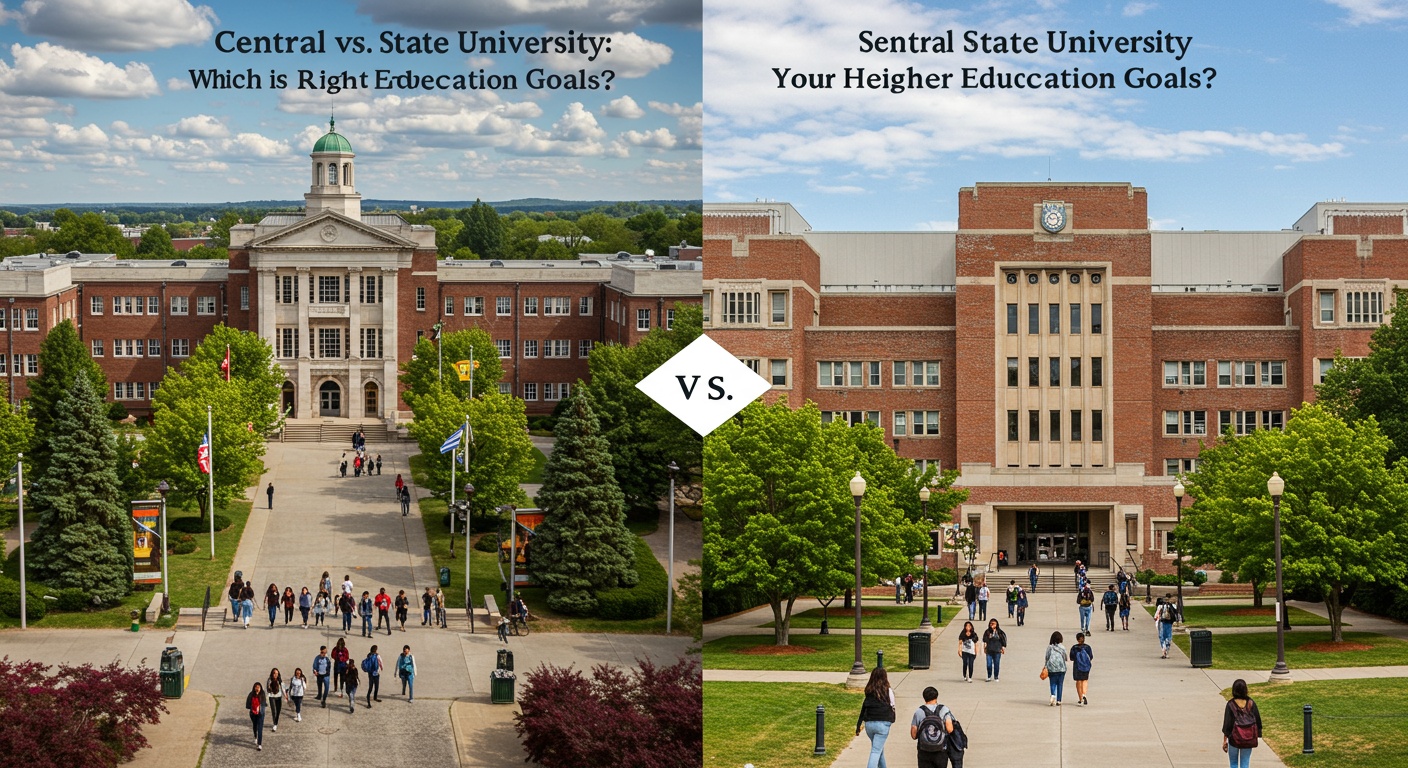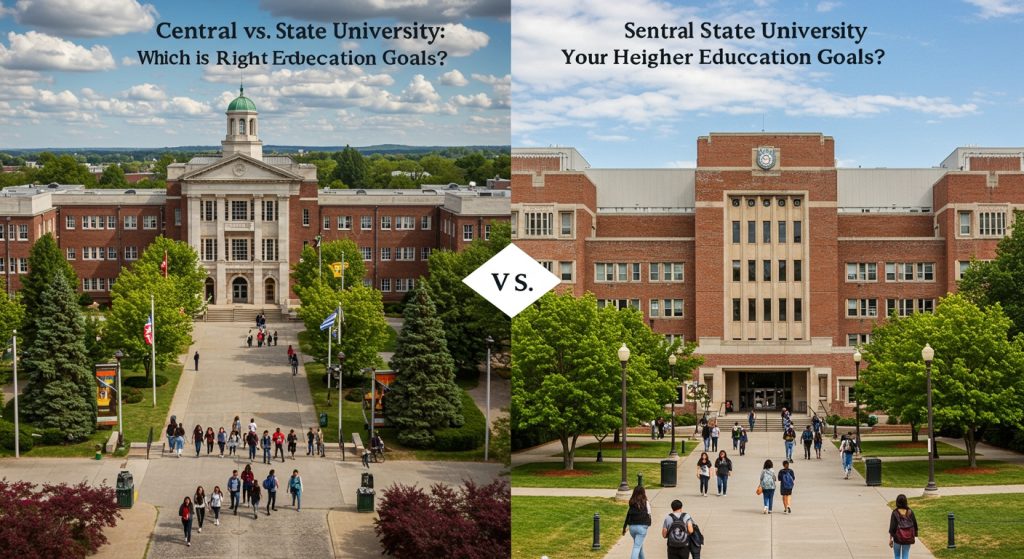Navigating higher education involves a critical decision: central versus state university. Consider this: central universities, often federally funded, like the University of Science and Technology of China, emphasize research and attract top global talent, influencing national policy. State universities, such as the University of California system, focus on broader accessibility and regional development, aligning curricula with local industry needs, such as tech in Silicon Valley or agriculture in the Central Valley. Key criteria for evaluation include research opportunities, faculty expertise, tuition costs. Program alignment with career aspirations. We’ll review these factors, helping you determine which type of institution best fits your academic and professional goals, ensuring a return on your educational investment.

Understanding the Landscape: Central vs. State Universities
Choosing the right university is a pivotal decision that can shape your future career and personal development. Navigating the higher education landscape requires understanding the key differences between central and state universities. While both offer undergraduate and graduate programs, their governance, funding. Focus often differ significantly, impacting the student experience. Central universities, also known as federal universities, are established and funded by the central government. They operate under the direct purview of the Ministry of Education and often have a national mandate, aiming to serve students from all parts of the country. State universities, on the other hand, are established and funded by the state government where they are located. Their primary focus is usually on serving the educational needs of the state’s residents.
Governance and Funding Models
The most significant difference between central and state universities lies in their governance and funding. This impacts everything from tuition fees to research opportunities and infrastructure development. Central Universities: Governance: Governed by central government acts and regulations. The President of India typically acts as the Visitor of the university. Funding: Primarily funded by the central government, with grants allocated based on national priorities and performance. This often translates to more substantial funding per student compared to state universities. Fee Structure: Generally, central universities have a relatively uniform and often subsidized fee structure, making them accessible to a wider range of students. Admission: Admission processes are often standardized and national in scope, attracting students from diverse backgrounds. State Universities: Governance: Governed by state government acts and regulations. The Governor of the state typically acts as the Chancellor of the university. Funding: Primarily funded by the state government, with funding levels often subject to state budgetary constraints and political priorities. This can lead to fluctuating levels of resources and infrastructure development. Fee Structure: Fee structures can vary significantly between state universities and are often influenced by the state’s economic conditions. Admission: Admission processes often prioritize students from the state, with reservation policies and domicile requirements playing a significant role.
Academic Programs and Specializations
The types of academic programs offered by central and state universities can also differ. Central universities often have a broader range of specialized programs and research-oriented departments, reflecting their national mandate. State universities, while also offering a wide range of programs, may have a stronger focus on disciplines that cater to the specific needs of the state’s economy and industries. Central Universities: Research Focus: Strong emphasis on research and development, often with specialized research centers and collaborations with national and international institutions. Program Diversity: Offer a wide range of programs, including specialized disciplines that may not be available in all state universities. Faculty Expertise: Often attract faculty with national and international recognition due to better funding and research opportunities. Example: Jawaharlal Nehru University (JNU) is known for its strong humanities and social sciences programs, attracting students from across India. State Universities: Regional Focus: Programs often tailored to the specific needs of the state, such as agriculture, regional languages. Local industries. Practical Training: Strong emphasis on practical training and vocational skills to enhance employability in the state. Community Engagement: Often involved in community outreach programs and initiatives that address local issues. Example: Anna University in Tamil Nadu is renowned for its engineering programs that cater to the state’s thriving manufacturing and technology sectors.
Infrastructure and Resources
The infrastructure and resources available at central and state universities can significantly impact the student learning experience. Central universities, with their generally stronger funding base, often have better-equipped libraries, laboratories. Other academic facilities. But, some state universities, particularly those with strong state government support or alumni contributions, can also boast world-class infrastructure. Central Universities: Libraries: Well-stocked libraries with access to a wide range of online resources and databases. Laboratories: Modern and well-equipped laboratories for scientific research and practical training. Hostel Facilities: Adequate hostel facilities for students from different parts of the country. Sports Facilities: Comprehensive sports facilities to promote physical fitness and extracurricular activities. State Universities: Infrastructure Variation: Infrastructure quality can vary significantly depending on the state’s economic conditions and government priorities. Local Resources: Access to local resources and industries for internships and practical training. Community Support: Strong community support and alumni networks that contribute to infrastructure development. Digital Infrastructure: Increasing investment in digital infrastructure, such as Wi-Fi connectivity and online learning platforms.
Career Opportunities and Alumni Networks
The career opportunities and alumni networks associated with central and state universities can also influence your career prospects. Central universities often have a broader national and international alumni network, which can be advantageous for students seeking opportunities beyond their home state. State universities, on the other hand, often have strong ties with local industries and businesses, providing students with valuable internship and job placement opportunities within the state. Central Universities: National and International Reach: Alumni networks that span across the country and around the world, providing access to a wider range of career opportunities. Recruitment by Top Companies: Often targeted by top national and international companies for recruitment. Higher Education Opportunities: Strong pathways to postgraduate studies and research opportunities in top universities globally. Example: The alumni of the Indian Institutes of Technology (IITs), which are central universities, are highly sought after by companies worldwide. State Universities: Local Industry Connections: Strong ties with local industries and businesses, providing valuable internship and job placement opportunities within the state. Regional Employment: Graduates often find employment in the state’s government sector, public sector undertakings. Private companies. Entrepreneurial Opportunities: Opportunities to start businesses and contribute to the state’s economy. Example: Graduates of state agricultural universities often play a key role in the state’s agricultural development and food security.
Cost of Education and Financial Aid
The cost of education is a significant factor for many students and families. Central universities often have lower tuition fees compared to private institutions, making them more affordable. State universities also tend to have lower fees for students from the state. Fees can vary depending on the program and the university’s financial situation. Both central and state universities offer various scholarships and financial aid programs to support students from disadvantaged backgrounds. Central Universities: Subsidized Fees: Generally lower tuition fees due to central government subsidies. National Scholarships: Offer a range of national scholarships and financial aid programs. Merit-Based Scholarships: Merit-based scholarships for outstanding academic performance. Need-Based Scholarships: Need-based scholarships for students from economically weaker sections. State Universities: State Government Scholarships: Offer scholarships and financial aid programs funded by the state government. Fee Concessions: Fee concessions for students from specific categories, such as reserved categories and economically backward classes. Educational Loans: Facilitate access to educational loans from banks and financial institutions. Private Scholarships: Partnerships with private organizations to offer scholarships and financial aid.
Campus Culture and Student Life
The campus culture and student life at central and state universities can also differ. Central universities often have a more diverse student body, with students from all parts of the country and sometimes even international students. This can lead to a more vibrant and cosmopolitan campus environment. State universities, while also diverse, tend to have a stronger regional flavor, reflecting the culture and traditions of the state. Central Universities: Diverse Student Body: Students from diverse backgrounds and cultures from across the country. National Perspective: Exposure to different perspectives and ideas, fostering a national outlook. Extracurricular Activities: A wide range of extracurricular activities, clubs. Organizations. Cultural Events: Opportunities to participate in national-level cultural events and competitions. State Universities: Regional Culture: Strong emphasis on the state’s culture, traditions. Languages. Community Engagement: Opportunities to engage with the local community and contribute to its development. Festivals and Celebrations: Participation in local festivals and celebrations. Language Proficiency: Emphasis on proficiency in the state’s official language.
Making the Right Choice: Aligning with Your Goals
Ultimately, the decision of whether to attend a central or state university depends on your individual goals, priorities. Circumstances. Consider the following factors when making your choice: Academic Interests: Choose a university that offers strong programs in your areas of interest. Career Aspirations: Consider the career opportunities and alumni networks associated with each type of university. Financial Resources: Evaluate the cost of education and the availability of financial aid. Personal Preferences: Consider the campus culture, student life. Location of the university. If you aspire to pursue research, seek a diverse national environment. Have the opportunity to explore various academic disciplines, a central university might be the better option. Many of the Top Central Universities offer these opportunities. On the other hand, if you prefer to study in your home state, contribute to the local community. Pursue a career within the state, a state university might be a more suitable choice. Here’s a table summarizing the key differences:
| Feature | Central University | State University |
|---|---|---|
| Governance | Central Government | State Government |
| Funding | Central Government | State Government |
| Fee Structure | Generally Uniform and Subsidized | Varies by State and University |
| Admission | National Scope | State Prioritization |
| Program Focus | Research-Oriented, Diverse | Regionally Focused, Practical |
| Infrastructure | Generally Better Equipped | Varies by State Support |
| Alumni Network | National and International | Local and Regional |
| Cost of Education | Lower Tuition Fees | Lower Fees for State Residents |
| Campus Culture | Diverse, Cosmopolitan | Regional, Community-Oriented |
Conclusion
Choosing between a central and state university is a deeply personal decision, one that hinges on your individual academic aspirations, financial realities. Desired learning environment. We’ve explored the unique strengths of each, from the specialized research focus and often higher prestige of central universities to the accessibility and community engagement frequently found at state institutions. Now, it’s time to synthesize this knowledge and put it into action. Think of this as your personal implementation guide. First, revisit your initial goals. Are you aiming for a highly specialized field requiring cutting-edge research facilities, something often found in central universities? Or are you seeking a broader, more community-oriented learning experience, potentially at a state university with strong ties to local industries? Next, meticulously compare the programs, faculty expertise. Available resources at your shortlisted institutions. Don’t just look at tuition fees; consider the overall cost of living and potential scholarship opportunities. Finally, visit the campuses, talk to current students. Get a feel for the campus culture. Success here isn’t just about graduating; it’s about finding a university that empowers you to thrive academically, personally. Professionally. Remember, the “best” university is the one that best fits you.
More Articles
Unlock Your Potential: University Career Services and Resources Available to You
Ace College: Proven Study Habits for Better Grades and Less Stress
Liberal Arts Colleges: Are They Still Worth It in 2025?
Future-Proof Your Degree: Top Skills Students Need for 2025
FAQs
So, Central University vs. State University… What’s the real difference, anyway?
Good question! Central Universities are funded and regulated by the central government of India. State Universities, you guessed it, are funded and regulated by the state government. This can impact things like fees, curriculum. Even reservation policies.
Does the funding source actually matter to me as a student?
Potentially, yes. Central Universities often have more diverse funding sources, sometimes leading to better infrastructure and research opportunities. State Universities, being state-funded, might have lower tuition fees and cater specifically to the needs and priorities of that particular state.
Okay. What about the quality of education? Is one ‘better’ than the other?
It’s not as simple as saying one is universally better. Quality varies greatly within both Central and State Universities. Look at rankings, faculty profiles, alumni success. Specific program accreditations rather than just the funding source.
How do admission processes typically differ between the two?
Central Universities often conduct national-level entrance exams like CUET (Common University Entrance Test). State Universities might have their own entrance exams or rely on state-level merit lists. Check the specific university’s website for the most up-to-date data – it changes!
What if I’m worried about the cost of attending? Are there scholarship differences?
Scholarship opportunities exist for both. The types can vary. Central Universities might have scholarships from the central government or private organizations. State Universities often have scholarships specifically for students from that state. Research both types thoroughly!
What should I consider when deciding which type of university is a better fit for my goals?
Think about your priorities! Are you looking for a specific program, a particular location, a lower tuition fee, or strong research opportunities? Weigh these factors against what each university (Central or State) offers. You’ll be on the right track.
So, ultimately, how do I choose between a Central and State University?
Do your homework! Research specific universities that offer your desired program. Compare their faculty, facilities, fees, location. Career placement rates. Talk to current students and alumni if possible. Don’t just assume one type is automatically better – it’s all about finding the best fit for you!



